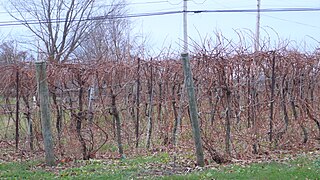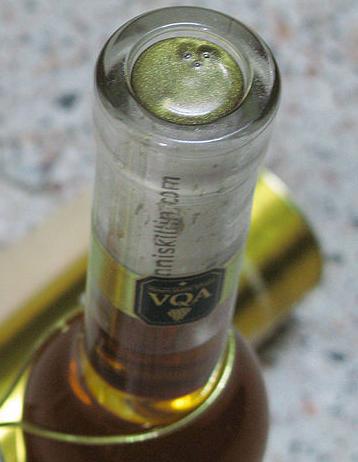
Ice wine is a type of dessert wine produced from grapes that have been frozen while still on the vine. The sugars and other dissolved solids do not freeze, but the water does, allowing for a more concentrated grape juice to develop. The grapes' must is then pressed from the frozen grapes, resulting in a smaller amount of more concentrated, very sweet juice. With ice wines, the freezing happens before the fermentation, not afterwards. Unlike the grapes from which other dessert wines are made, such as Sauternes, Tokaji, or Trockenbeerenauslese, ice wine grapes should not be affected by Botrytis cinerea or noble rot, at least not to any great degree. Only healthy grapes keep in good shape until the opportunity arises for an ice wine harvest, which in extreme cases can occur after the New Year, on a northern hemisphere calendar. This gives ice wine its characteristic refreshing sweetness balanced by high acidity. When the grapes are free of Botrytis, they are said to come in "clean".
An appellation is a legally defined and protected geographical indication primarily used to identify where the grapes for a wine were grown, although other types of food often have appellations as well. Restrictions other than geographical boundaries, such as what grapes may be grown, maximum grape yields, alcohol level, and other quality factors may also apply before an appellation name may legally appear on a wine bottle label. The rules that govern appellations are dependent on the country in which the wine was produced.

Baco noir is a hybrid red wine grape variety produced by Francois Baco from a cross of Vitis vinifera var. Folle blanche, a French wine grape, and an unknown variety of Vitis riparia indigenous to North America.
Vitis labrusca, the fox grape, is a species of grapevines belonging to the Vitis genus in the flowering plant family Vitaceae. The vines are native to eastern North America and are the source of many grape cultivars, including Catawba, Concord, Delaware, Isabella, Niagara, and many hybrid grape varieties such as Agawam, Alexander and Onaka. Among the characteristics of this vine species in contrast to the European wine grape Vitis vinifera are its "slip-skin" that allows the skin of the grape berries to easily slip off when squeezed, instead of crushing the pulp, and the presence of tendrils on every node of the cane. Another contrast with European vinifera is the characteristic "foxy" musk of V. labrusca, best known to most people through the Concord grape. This musk is not related to the mammalian fox, but rather to the strong, earthy aromas characteristic of the grapes that were known by early European-American settlers in the New World. The term "foxy" became a sort of catchall for the wine tasting descriptors used for these American wines that were distinct from the familiar flavors of the European viniferous wines.

Vidal blanc is a white hybrid grape variety produced from the Vitis vinifera variety Ugni blanc and another hybrid variety, Rayon d'Or. It is a very winter-hardy variety that manages to produce high sugar levels in cold climates with moderate to high acidity.

Canadian wine is wine produced in Canada. Ontario and British Columbia are the two largest wine-producing provinces in Canada, with two-thirds of the Canada's vineyard acreage situated in Ontario. However, wine producing regions are also present in other provinces, including Alberta, Quebec, New Brunswick and Nova Scotia.

Illinois wine refers to any wine that is made from grapes grown in the U.S. state of Illinois. In 2006, Shawnee Hills, in southern Illinois, was named the state's first American Viticultural Area. As of 2008, there were 79 wineries in Illinois, utilizing approximately 1,100 acres (4.5 km2) of vines.

Washington wine is a wine produced from grape varieties grown in the U.S. state of Washington. Washington ranks second in the United States in the production of wine. By 2017, the state had over 55,000 acres (220 km2) of vineyards, a harvest of 229,000 short tons (208,000 t) of grapes, and exports going to over 40 countries around the world from the 940+ wineries located in the state. While there are some viticultural activities in the cooler, wetter western half of the state, the majority (99.9%) of wine grape production takes place in the shrub-steppe eastern half. The rain shadow of the Cascade Range leaves the Columbia River Basin with around 8 inches (200 mm) of annual rain fall, making irrigation and water rights of paramount interest to the Washington wine industry. Viticulture in the state is also influenced by long sunlight hours and consistent temperatures.

Ontario wine is Canadian wine produced in the province of Ontario. The provinces has three official wine-growing region, the Niagara Peninsula, the north shore of Lake Erie, and Prince Edward County, although wineries also exist in other regions in Ontario. Approximately two-thirds of Canada's vineyard acreage is situated in Ontario, with over 150 vineyards spread across 6,900 hectares. As a result, the province is the country's largest producer of wine, accounting for 62 per cent of Canadian wine production, and 68 per cent of all Canadian wine exports.
The Short Hills Bench is a sub-appellation of the Niagara Peninsula.

Henry of Pelham Family Estate Winery is an Ontario winery that released their first vintage in 1988. The namesake of the winery, Henry (Smith) of Pelham was an early settler in Upper Canada’s Niagara Peninsula. His father Nicholas, the first settler, was Pennsylvania Dutch and a United Empire Loyalist who sided with the crown during the American Revolution of 1776.

Inniskillin is a Canadian winery located in Niagara-on-the-Lake, Ontario. Inniskillin, which is mainly noted for its icewine production, has played an important pioneering role in the modern Canadian wine industry. Since 1994, Inniskillin also operates a winery in Okanagan, British Columbia in addition to its original location.

Depending on the province in which it is produced, Cellared in Canada is a category of Canadian wine that is produced with varying quantities of foreign bulk wine and Canadian wine. These wines are often sold in government-run liquor stores in sections designated as "Canadian wine". In British Columbia, Cellared in Canada wine may be produced from 100 percent foreign content with grapes grown from Washington State, California, South Africa, Argentina, Chile. and possibly even China. In Ontario, Cellared in Canada wine is allowed to be produced from a blend of no more than 60 percent foreign-sourced content. Within the 40 percent Ontario content, dilution with water is not allowed. The only indication of origin is found on the back of the bottle, with a term such as "Cellared in Canada from international and domestic wines". Other permitted terms are "Product of Canada" and "Vinted in Canada".

British Columbia wine is Canadian wine produced in the province of British Columbia. Wines made from 100% British Columbia grapes can qualify for classification under one of British Columbia's two classification systems, depending on the variety, the winemaking techniques employed, and various other restrictions.
Pelee Island Winery is a winery in Kingsville, Ontario, Canada. They have over 700-acre (2.8 km2) of vineyards on Pelee Island, which is in the South Islands Sub-Appellation of the Lake Erie North Shore Appellation of Ontario along the shores of Lake Erie. https://www.vqaontario.ca/Appellations/LakeErieNorthShore

Reif Estate Winery is located in Niagara-on-the-Lake in Ontario, Canada. Reif Estate is primarily known for playing an important in role pioneering the Ontario wine Industry, as well as planting some of the first Vitis vinifera vines in the Niagara region.

Nova Scotia wine is Canadian wine produced in the Canadian province of Nova Scotia. Nova Scotia's wineries are primarily organized under the Wine Association of Nova Scotia, though not all wineries are members. The industry began in the late 1970s with the original Grand Pré Winery in the Annapolis Valley of Nova Scotia.

The Okanagan Valley wine region, located within the region of the same name in the British Columbia Interior, is Canada's second-largest wine producing area. Along with the nearby Similkameen Valley, the approximately 8,619 acres of vineyards planted in the Okanagan account for more than 80% of all wine produced in British Columbia, and are second in economic importance for wine production to the Niagara Peninsula of Ontario. Some 182 licensed wineries existed from south to north in the valley in 2018, with many situated along the 135 km (84 mi)-long Okanagan Lake and its tributaries and downstream lakes, including Skaha Lake, Vaseux Lake, and Osoyoos Lake. The Okanagan has diverse terrain that features many different microclimates and vineyard soil types, contributing characteristics which are part of an Okanagan terroir.

Mission Hill Family Estate is a wine grower and producer based in West Kelowna, British Columbia, Canada, in the Okanagan Valley wine region. The winery is situated atop Mission Hill overlooking a 145 kilometre lake, mountains and vineyards.

L'Acadie blanc is a white Canadian wine grape variety that is a hybrid crossing of Cascade and Seyve-Villard 14-287. The grape was created in 1953 by grape breeder Ollie A. Bradt in Niagara, Ontario at the Vineland Horticultural Research Station which is now the Vineland Research and Innovation Centre. Today the grape is widely planted in Nova Scotia with some plantings in Quebec and Ontario. Some wine writers, including those at Appellation America, consider L'Acadie blanc as "Nova Scotia’s equivalent to Chardonnay".

















